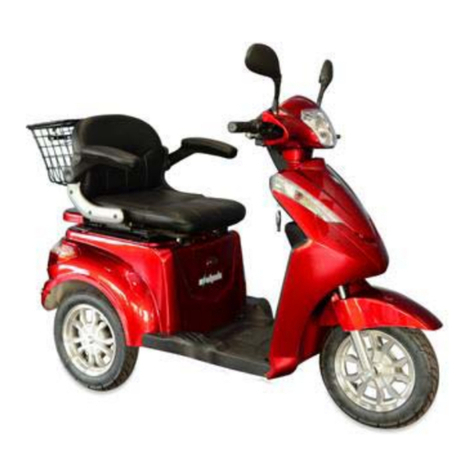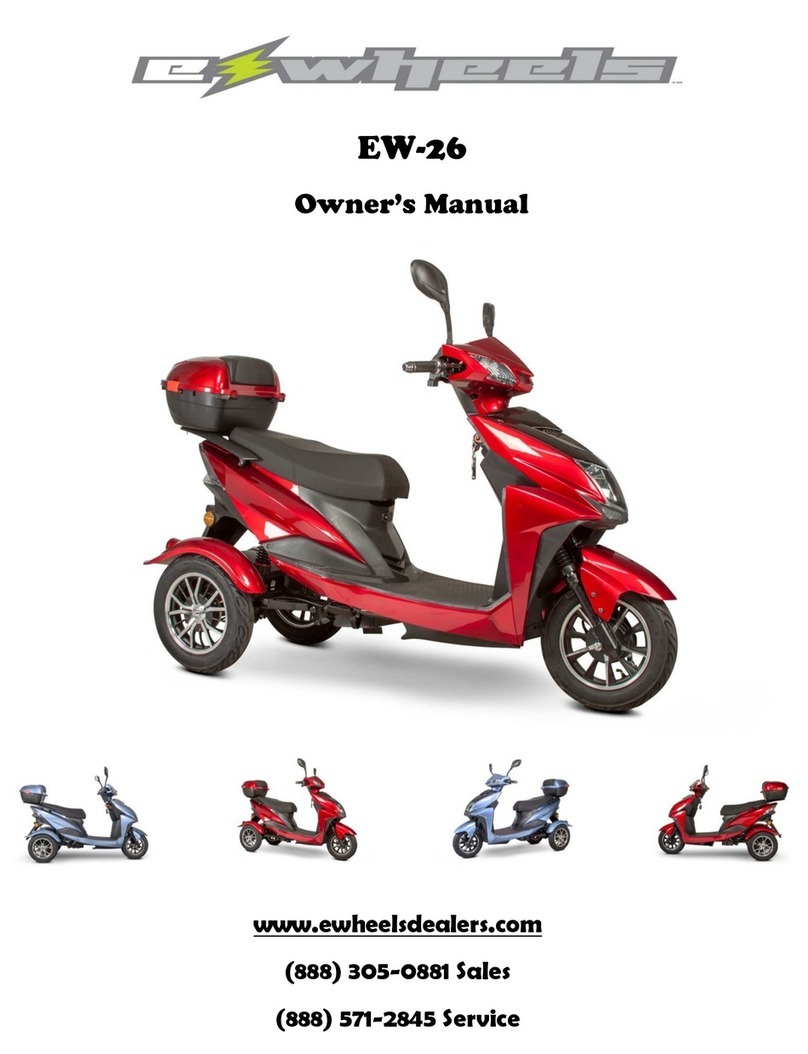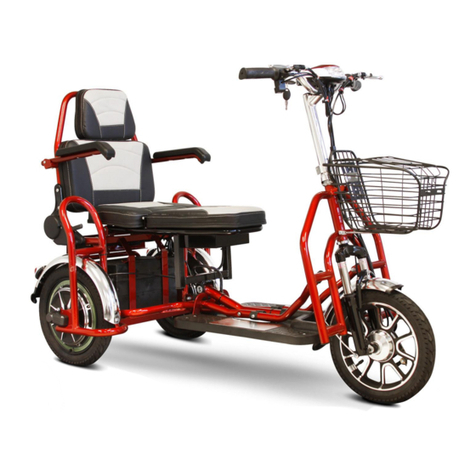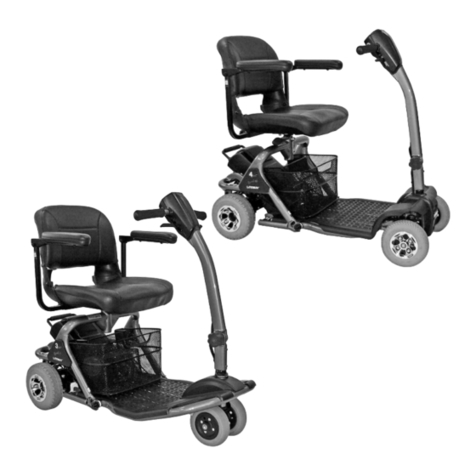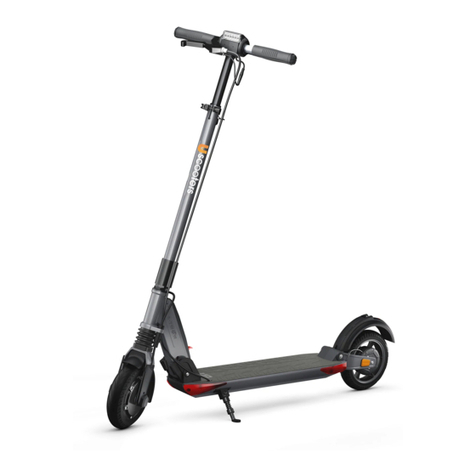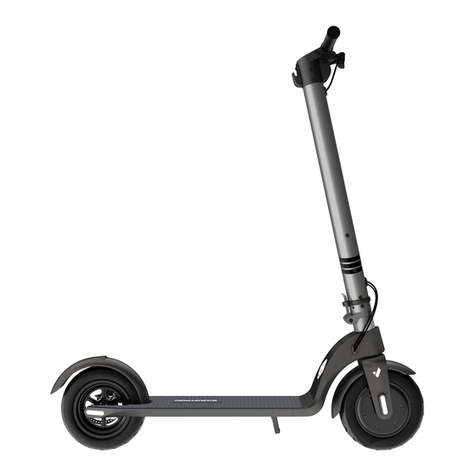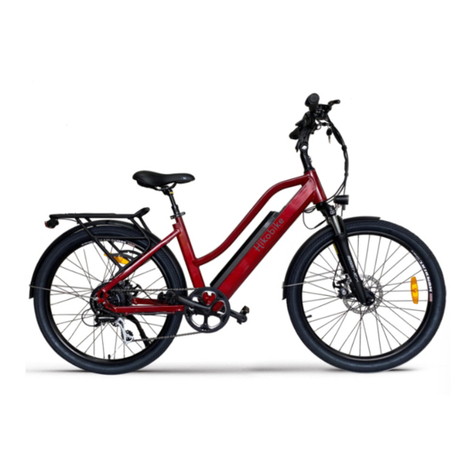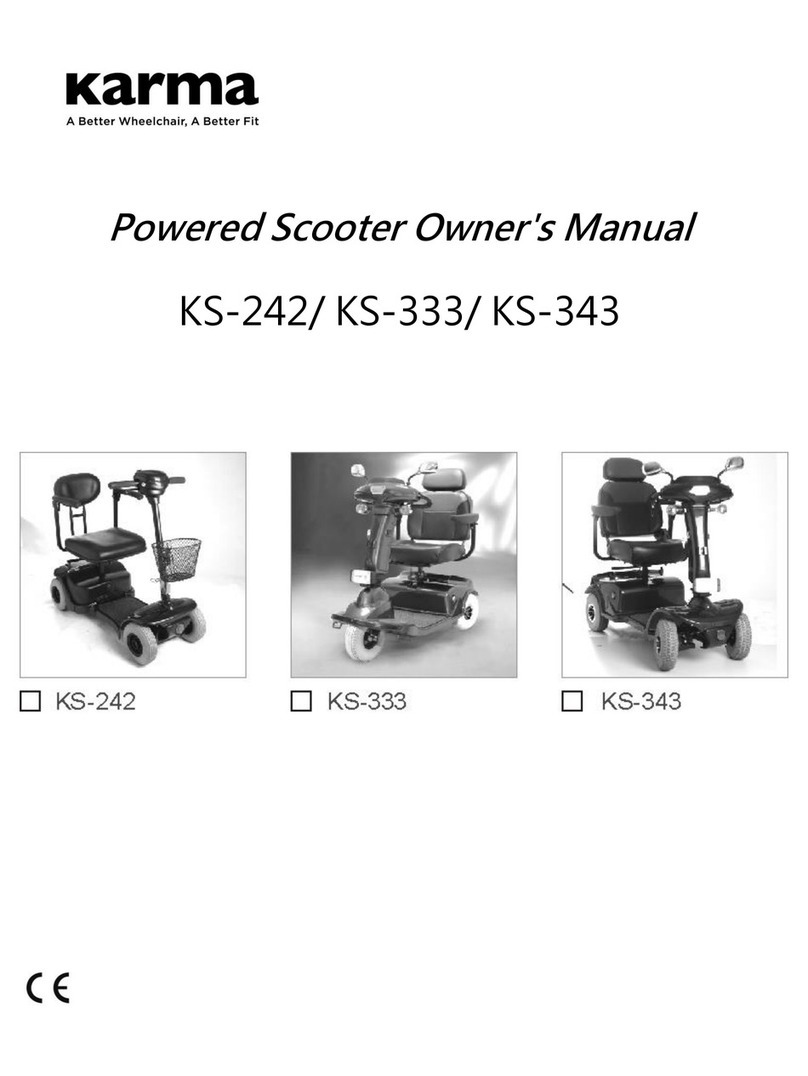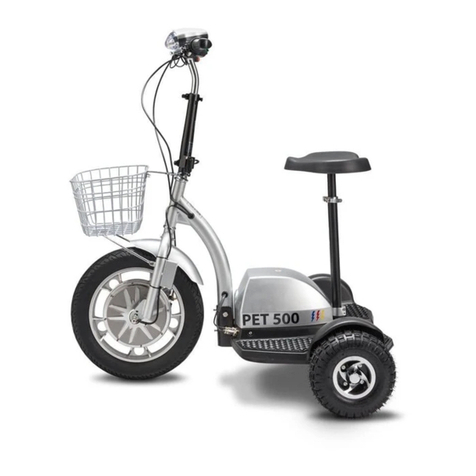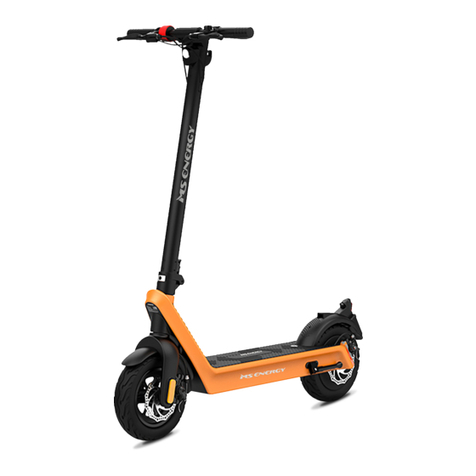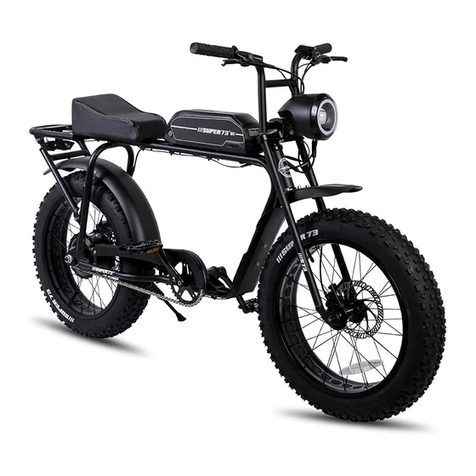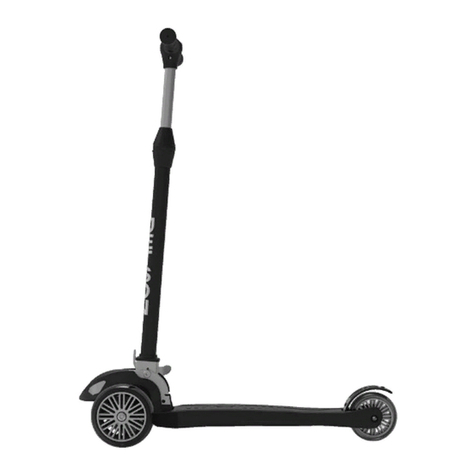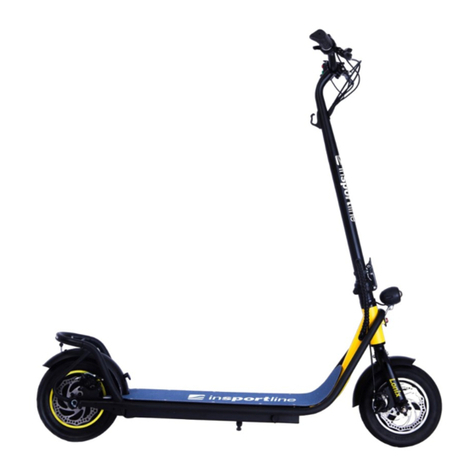ewheels EW-46 Operating instructions

EW-46
Service & Repair Manual

2
Table of Contents
Contents
Customer Diagnosis............................................................................................................... 2
Complete Loss of Power: ................................................................................................................2
Loss of Throttle Response:..............................................................................................................3
Section 2 –Technician Diagnosis Guide.................................................................................. 4
All Possible Tools Needed:..........................................................................................................4
Complete Loss of Throttle Response:.........................................................................................5
Checking Connections.................................................................................................................5
Testing the Throttle: .............................................................................................................................6
Testing the Rheostat (Speed Knob/Potentiometer):............................................................................7
Testing the Wire Harness:.....................................................................................................................8
Testing the Controller: ..........................................................................................................................9
Testing the Motor ........................................................................................................................11
Intermittent or Random Loss of Throttle Issue ..............................................................................12
Section 3- Upkeep and Maintenance.................................................................................... 16
Daily Checks Before Riding ...........................................................................................................16
Customer Diagnosis
Complete Loss of Power:
1.) If the scooter has no power when turned on, the first thing to check is that the circuit breaker
underneath the seat* is flipped to the on position. If the circuit breaker is labeled with an “I’ and
an “O”, the “I’ is the on position.
www.ewheelsdealers.com
(888) 571-2845 - Service
(888) 305-0881 - Sales
(888) 571-2845 Service

3
2.) Check that the light on the charger turns from green while plugged just into the wall outlet,
to red when plugged into the scooter and wall outlet.
If neither of these steps returns power or the charger light is staying green, please contact
EWheels service department directly for assistance
Loss of Throttle Response:
1.) If the throttle does not respond when turned, the first thing to check is the current battery
charge. Look at the battery indicator when the scooter power it turned on. If the scooter is not
displaying a full charge, please fully charge the machine
2.) The only feature of the EW-46 that can cut off power to the motor is the brake sensors that
are within the brake handles. To check the brake sensors, pull the brake handle while looking at
the taillights with the scooter’s power turned on. If the sensors are working correctly, the brake
lights will illuminate when the brake handle is pulled and turn back off when the brake handle is
released.
3.) If the above steps have been followed and the machine is still not driving, the next step is to
reset the controller (brain) for the scooter. Turn the circuit breaker to the off (“O”) position, and
let it sit in the off position for a minimum of three hours to allow for the controller (brain) to
restart.
Loss of All Lights:
1. If all lights will not come on at all even the power light on the dash, it’s more than likely
going be a voltage regulator in the rear of the scooter, under the seat, under the storage
box. It’s a small metal box with 1 connection going to it. (See page 37)
Charging Issues:
If the scooter is completely dead the charger will show a Green Light but only for about 30min to
1 hour. After the time it will switch over the red light indicating that the scooter is charging. If it
stays green, then you would need to test the charger.
If you are noticing that your scooter is getting less and less miles every time its full you might
need to get the batteries checked. A good indication that you might have bad batteries is if you
have a full charge and when twisting the throttle, the battery level drops very low.
If following these steps still do not allow the scooter to drive, please contact Ewheels service
department directly for assistance.
*If unsure on how to open the seat, please check page 8 of the owner’s manual.

4
Section 2 –Technical Diagnosis Guide
All Possible Tools Needed:
1.) Metric wrench set
2.) Metric socket wrench set
3.) Metric hex wrench set
4.) Phillips head screwdriver set (#1, #2, #3)
5.) Multimeter or voltage tester
6.) Floor jack (optional, not needed)
7.) Solder pen and solder
8.) Shrink wrap tubing
9.) Zip ties (any length or color)
10.) Box cutter
11.) Wire stripper
12.) 3/8th Rachet (Extensions If Needed )

5
Throttle Power loss/ Throttle Testing:
Checking Connections
Start by checking all connections on both ends of the wire harness, focusing specifically on the
three-wire throttle connector and motor wires. Make sure no pins are pulling out of the backside
of any connectors, and that the pins on the female side of connectors are not folded over to the
side of the connectors.
There are very rare instances where a short in the accessory wiring can cause the machine not to
drive. To ensure this is not the issue, please leave lights, turn signals, and all other accessories
turned off.
A continuity test can be run on each side of connectors to ensure there is not an issue with the
connector pins making proper contact. Connections can be checked by separating the connecting
pins, one separated the pins can be folded or pulled out of the connectors.

6
Testing the Throttle:
The throttle responds via a hall effect positioning sensor. The sensor increases its output voltage
the more the throttle is pulled. To test this sensor, start by turning the scooter on. Next, set your
multimeter to DC 20 volts (or closest setting). While leaving the scooter powered on, and
ensuring the throttle to harness, harness to controller, and controller to motor connections are
plugged in, insert the multimeter red lead into the throttle connections red wire, and the black
multimeter lead into the throttle connections black wire. The voltage reading should be around
.82 volts when the throttle is not being pulled
(no load).
If you are getting the correct voltage with
the power turned on, without pulling the
throttle (no load), then the next step is to
check the throttle voltage under load
(while pulling the throttle). The voltage
should increase to around 3.51 volts under
full load (while fully rotated). The scooter
should engage forward when the voltage
rating hits approximately 1.54 volts. If all
steps above are followed, and the scooter
is not driving, the throttle is not the
component causing the problem.
If the throttle is not working properly,
please contact EWheels service
department directly for a replacement.

7
Testing the Rheostat (Speed Knob/Potentiometer):
To test that the rheostat (speed knob/potentiometer) is working properly, you can disconnect it
from its wire harness connection, and try to see if a throttle response returns. This removes all
the limitation and ohm resistance from the positioning sensor in the throttle.
The rheostat can also be tested with a
multimeter. The rheostat will have an
OHM rating of 100k if it is a sport EW-
36, which is marked on the rheostat
itself. Set your multimeter to OHM
100K (or closest setting above 100K)
and use the two ports with the wires
soldered on to obtain an OHM reading.
Twist the knob with your leads attached,
and check that the rheostat varies from
approximately 0, to the 100k OHM's it is
rated for.
If the rheostat (speed
knob/potentiometer) is not working
properly, please contact EWheels
service department directly for a
replacement.

8
Testing the Wire Harness:
To test that the wire harness is working properly, visually inspecting and running continuity
checks will be necessary. Touch your leads together to see if your specific multimeter beeps
when there is continuity.
If your leads are long enough, you can run test of both ends of each wire on the wire harness. If
your leads are not long enough to reach both ends of the harness, you can find something
conductive to cross the pins of two wires in a connector that are located right by each other
(screwdriver tip, paperclip, or any other conductive
item you have available to you). Doing this will allow
for one multimeter lead to receive the voltage being
sent from the other multimeter lead, which helps to
verify there are no breaks in the wires being tested. If
crossing connections, ensure that the power is turned
off, and that both ends of the wire harness are not
plugged in.
Focus on testing the throttle wires, rheostat (speed
knob/potentiometer), and brake sensors, which all
pertain to drivability issues. Testing accessory wiring
is not needed when diagnosing drivability issues.
If the wire harness has breaks that are not able to be repaired, please contact EWheels service
department directly for a replacement.

9
Testing the Controller:
To test that the controller is working properly,
checking the output voltage for the throttles
positioning sensor will be necessary. Leave the
scooter power turned on while testing, but Do Not
cross the throttle wires or a short may occur
which can cause damage, personal injury, or
death.
Use the two outside wires of the three prong
throttle wires on the harness, shown in the picture,
to obtain a voltage reading. Set the multimeter to
DC 20 (or closest setting higher than 20). If the
controller is working properly, it should be
emitting approximately 3.48 volts while plugged
into the harness with the scooter power turned on,
or approximately 4.99 volts with the harness
connection unplugged. If there is no voltage under
load, this means the controller has failed and needs
to be replaced.
To test that the controller is emitting the proper voltage to the motor, connect your multimeter to
any color combination on the motor phase wires where they connect at the yellow junction box.
Set your meter at DC 50 or higher, and test under load (with the scooter power turned on, while
pulling the throttle). The voltage should start at 0 and increase between 2.5-3.6 volts while under
full load (holding the throttle pulled at the way).
*Continued next page*

10
Next, check that the controller
is supplying the motor Hall
Effect sensors with the proper
voltage, which is
approximately 4.95-5 volts.
Leave the scooter powered on
and the connector connected.
This reading should be
obtained at the black and red,
yellow and green, and green
and blue sensors wires while
not under load.
If the controller is not working properly, please contact EWheels directly for a replacement.

11
Testing the Motor
Start by testing the resistance at the motor phase lines using all color combinations. If your meter
displays any resistance levels other than infinite/zero, then the motor needs to be replaced.
Next, check that the Hall Effect positioning sensor’s
voltage is decreasing when the wheel is being
rotated. Rotate the wheel by hand, not with the
throttle.
While under a full load (with the throttle pulled all
the way) the motor should respond if the controller,
harness, and throttle have already been tested, and
the brake sensors and rheostat have already been
checked. If not, the motor needs to be replaced.
Going internal with the motor to determine if
the differential, transfer case, motor hall
sensors, or other internal components is the
issue is not recommended for field service
technicians. Typically, the labor costs for
disassembling, testing, and reassembling will
exceed the cost for a replacement motor. If the
control unit is emitting the proper power to
the motor under load, the brake sensor is not
activated, and the rheostat is unplugged, and
the motor is not engaging,

12
Intermittent or Random Loss of Throttle Issue
The scooter could be intermittently driving, or not consistently accelerating for three different reasons.
It could be a loose connection, a tension issue in the brake handle, or an issue with the batteries under
load.
1. Loose Connection
For random loss of throttle response while driving, start by checking both ends of the wire harness
connections for a loose wire pin or connector. Focus on wiring pertaining to drivability (throttle, brake
sensors, motor wires, speed knob wires).
2. Brake Tension
Lack of tension in the brake handle is the most
likely culprit to cause random loss of throttle
response while driving. The brake cables can
slightly stretch out during normal usage, and
the brake pads will wear from normal usage.
When the cable stretches and the brake pads
wear, this can cause the brake handle to
become loose and have a slight amount of play,
which can cause the brake sensor to activate
while riding randomly. To test if there is a lack
of tension in the brake handle, use one finger,
and tap the brake handle towards the hand grip
with the scooter power turned on. If the brake
lights turn on and off while you tap the handle
with a single finger, then this is the issue.

13
Battery Load Issue
If the scooter is fully charged, but the battery charge
indicator dips from high down to low when the throttle is
pulled, this indicates there is an issue with the batteries.
Testing the voltage of the batteries may indicate if the
batteries are charged or not but, does not indicate if there is
an issue with the batteries. To properly test, a load tester
like the one in the photo below must be used.
A load tester will be required to properly test the batteries
under load. However, if the batteries are multiple years old,
the scooter has issues accelerating, or if you experience any of
the symptoms above, then load testing can be skipped to avoid additional cost if needed. Sealed lead
acid batteries have a typical life span of 2-3 years which all depends on how they are maintained. If the
batteries are within this time frame and experiencing any of the above issues, replacement of all four (4)
batteries is recommended.

14
Testing the Charging System
To test the charging system, a multimeter or voltage tester will be required. If the scooter is not
recharging properly, testing the output voltage of the charger, and voltage at the charger port, will help
narrow down the issue may be.
1. Testing the Charger
To test the output voltage of the charger, plug the
chargers power supply directly into a wall outlet,
but not into the scooter. Set your multimeter to
DC 200 or higher and insert a multimeter lead
into each of the two parallel prongs as shown in
the photo below.
If the charger is working properly, it should be
emitting anywhere from 54 volts to 57 volts.
If the charger is not working properly, please
contact EWheels service department directly for a
replacement.

15
Testing the Charger Port
If the charger is emitting the proper voltage, the next item to test is voltage at the charger port. Set the
multimeter to DC 200 volts, or closest setting higher than 200 volts, and use the two parallel prongs to
obtain a voltage reading from the two parallel charger port prongs as shown in the photo below. Do not
cross the multimeter leads or charger port prongs, or damage and injury could occur.
This voltage reading will vary depending on the current charge of the scooter’s batteries. If there is no
voltage reading at all, this would indicate the batteries are completely discharged, or there is a wiring or
connection issue somewhere between the charger port leading back to the batteries. Run continuity test
on the battery terminal wires, wire harness connections, and charger port wiring to determine which is
the issue.
If the charger port, battery terminal wiring, or wire harness need to be replaced, please contact EWheels
service department directly.

16
Section 3- Upkeep and Maintenance
Daily Checks Before Riding
1. Charge Level
Make sure there is enough charge in the batteries to
complete the distance you intend to travel. If you are going
to be traveling more than half the rated capable mileage, a
full charge is recommended. Never let the batteries become
completely depleted or sit for an extended period
uncharged. Doing so will damage the batteries, decrease
the capable mileage, and shorten the useable life span of
the batteries. Periodically check the charge indicator needle
while using the scooter.
2. Brake Tension
Check tension in the brake lines by squeezing either
brake handle to see if it can travel and touch the
hand grip. If it is, tension will need to be added to the
brake lines. Test both handles for a lack tension.

17
Brake Tension Continued- Increasing tension in the brake lines will eliminate this issue. The
right-hand brake controls the front brake. The left-hand brake controls the back brakes. Tighten
the adjustment nut on the effected handle to eliminate the issue.
3. Tire Pressure
Visually inspect the tires on all three wheels to make sure they all have ample tire pressure. If the
scooter has a tire that appears to be low, adding air to the tire will be required. Inspect the tire is
between 30-35 PSI daily.
A tire with ample pressure will appear like the one to the
right. Checking the exact PSI (pounds per square inch) with a
gauge is recommend monthly, opposed to daily.
A tire with a loss of tire pressure will appear like the one
photo to the left. If the tire appears to of lost pressure,
testing the PSI (pounds per square inch), and adding air to the
tire will be necessary.
When the PSI (pounds per square inch) is less than 15 pounds,
and air is added to the tire, it is recommended to avoid use for 24 hours. Check the pressure 24 hours
after it was added, to make sure the tire does not have a leak. If the tire does have a slow leak, spraying
soapy water on the tire can help locate the area where the air is leaking from. If there is a hole on the
tire from a puncture, a “tubeless tire repair kit” can be used to repair the hole in the tire. EWheels
directly does not sell “tubeless tire repair kits”, but they can be obtained at local stores or online.

18
If tires or wheels need to be replaced, please contact EWheels directly for a replacement.
Monthly Checks
It is recommended monthly to check that the rear axle securing nuts, front
axle bolt, seat bolts, headset bolt, transaxle to swing arm bolts, and the motor
to axle bolts.
The front wheel is held on by a bolt that is a 19mm. This
can be removed with a socket and rachet or wrench.
The rear wheel is held on by a bolt that is a 19mm. This
can be removed with a socket and rachet or wrench.
Front Axle Replacement
You are going to start with taking the front wheel off the unit. Once completely remove the brake
pads, then the brake hardware and take the wire out.

19
You will be using a 10 mm allene wrench and a 19 mm socket
wrench to loosen the nut to take the axle bolt off.
The seat is securing by two bolts, and the seat latch. The seat
bolts are a 5mm hex head bolt on the bolt side, and 10mm on

20
the nut side. Avoid overtightening or the seat will not be able to be lifted easily.
The headset bolt is a 13mm. Turn the handlebars to
either side to be able to gain access to the nut side.
There are two transaxles to swing arm bolts on each
side of the scooter. The bolt size is going to be . Make
sure the bolts are tight on each side. If there is a gap
between the axle bracket and the swing arm, this is
normal. If overtightened bolts from the transaxle to
swing arms can potentially snap.
There are five bolts on each side axle that securing the
axle housing to the differential/motor assembly. Make
sure all bolts are tightened with the same amount of
pressure to avoid potential oil leaks with a 5mm.
Table of contents
Other ewheels Scooter manuals
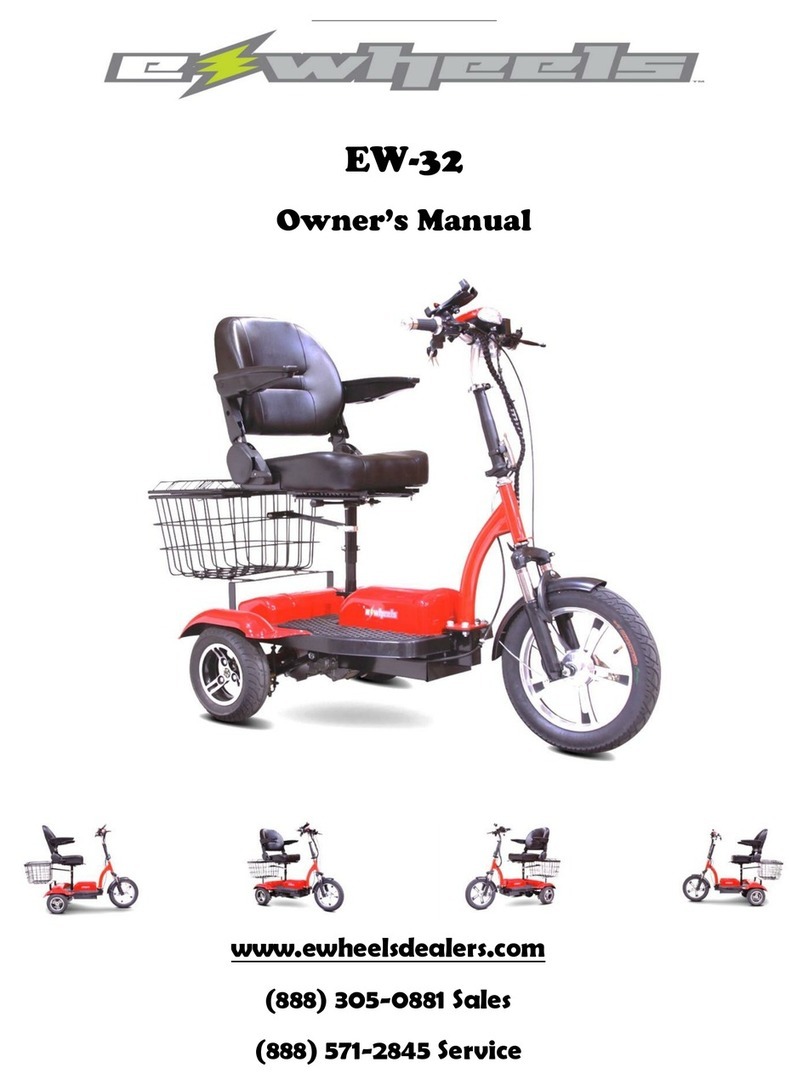
ewheels
ewheels EW-32 User manual
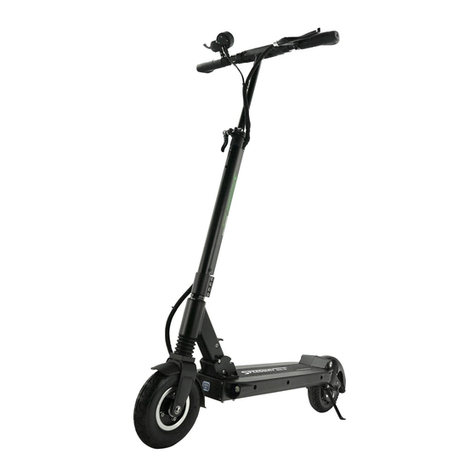
ewheels
ewheels Speedway Mini4-Pro User manual
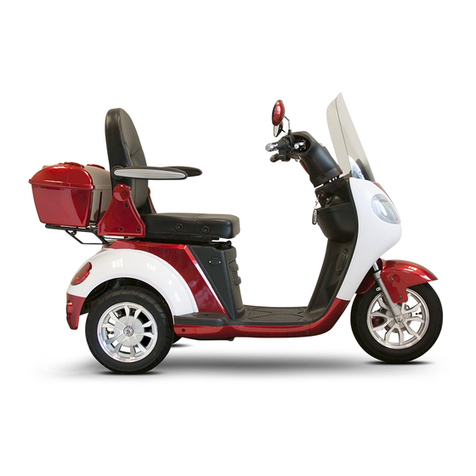
ewheels
ewheels EW-42 User manual
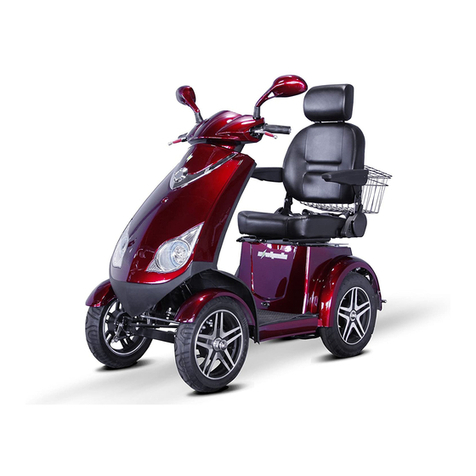
ewheels
ewheels EW-72 User manual

ewheels
ewheels EW-88 User manual
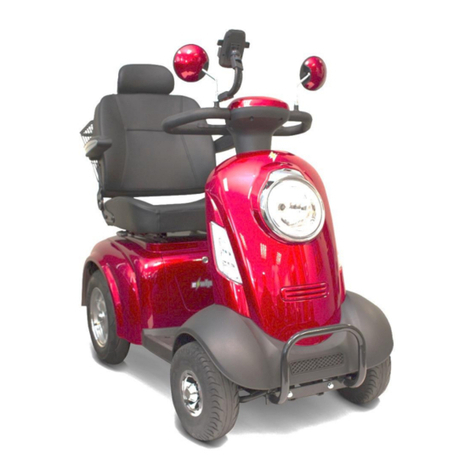
ewheels
ewheels EW-74 User manual
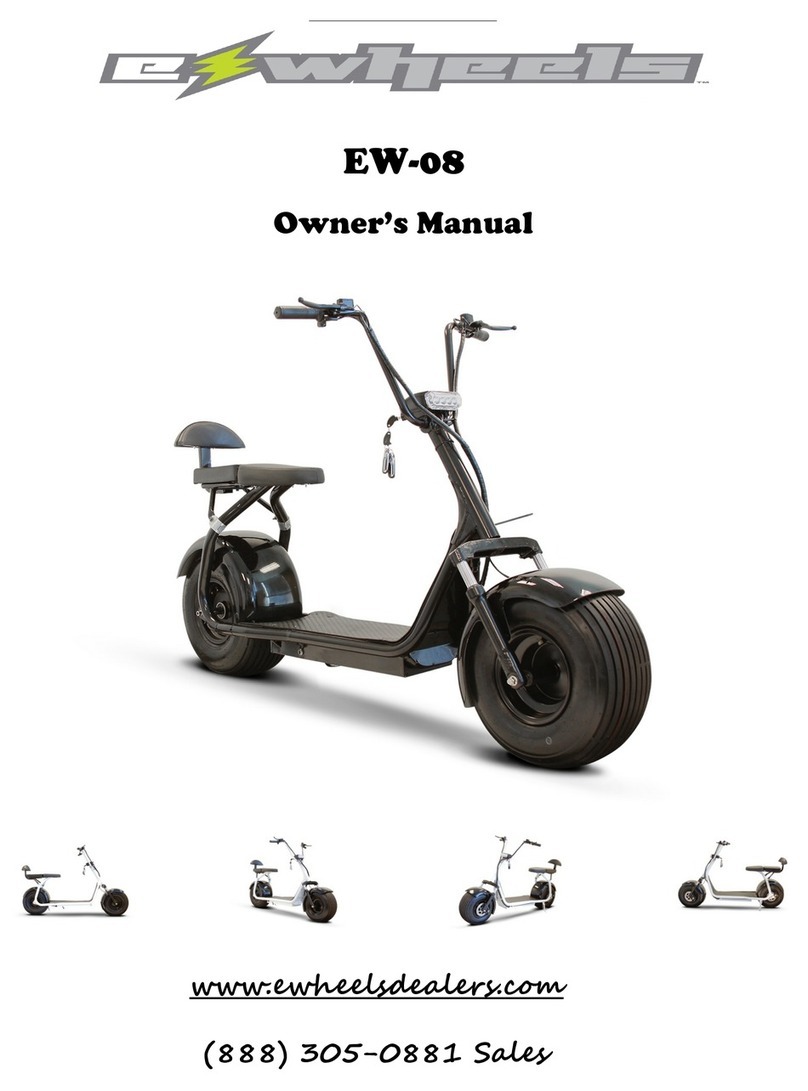
ewheels
ewheels EW-08 User manual
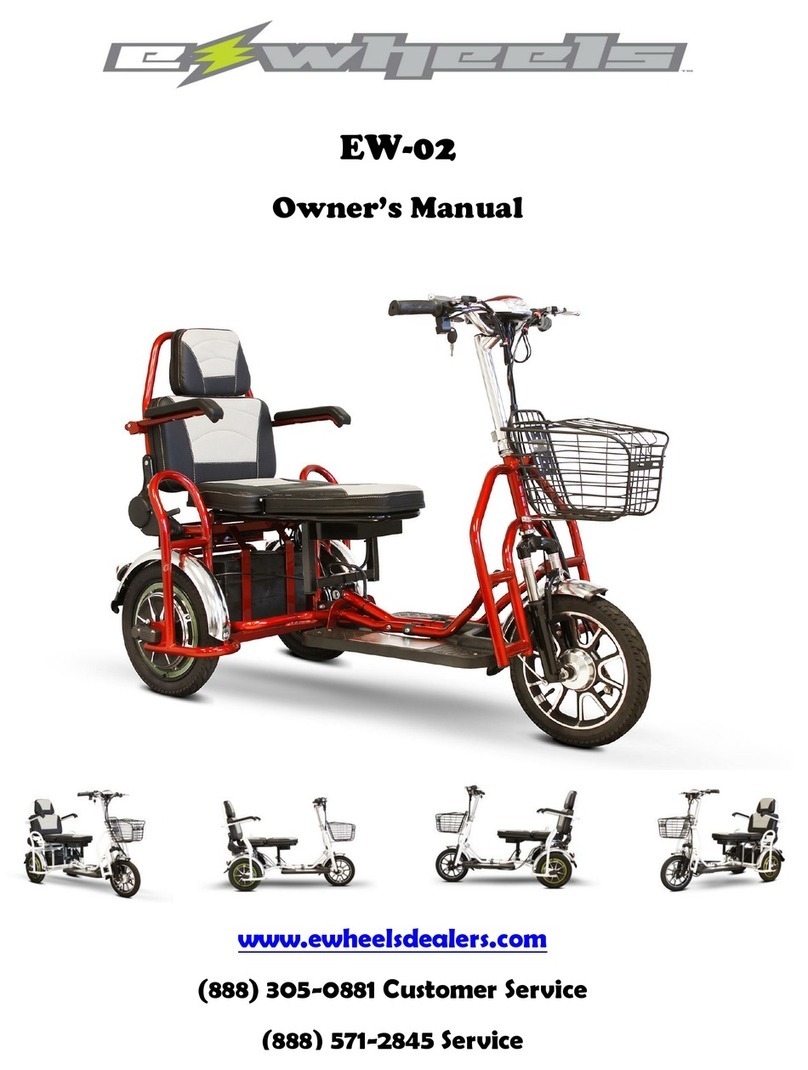
ewheels
ewheels EW-02 User manual
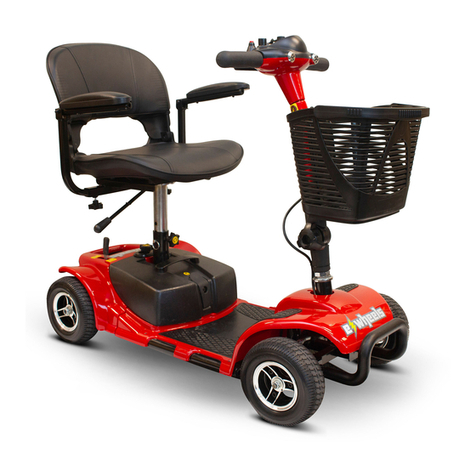
ewheels
ewheels EW-M34 User manual
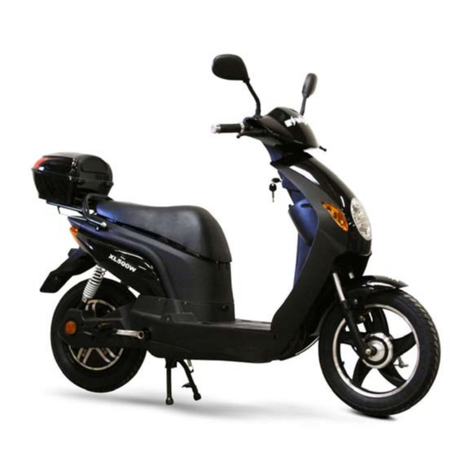
ewheels
ewheels EW-600 User manual

ewheels
ewheels EW-01 User manual
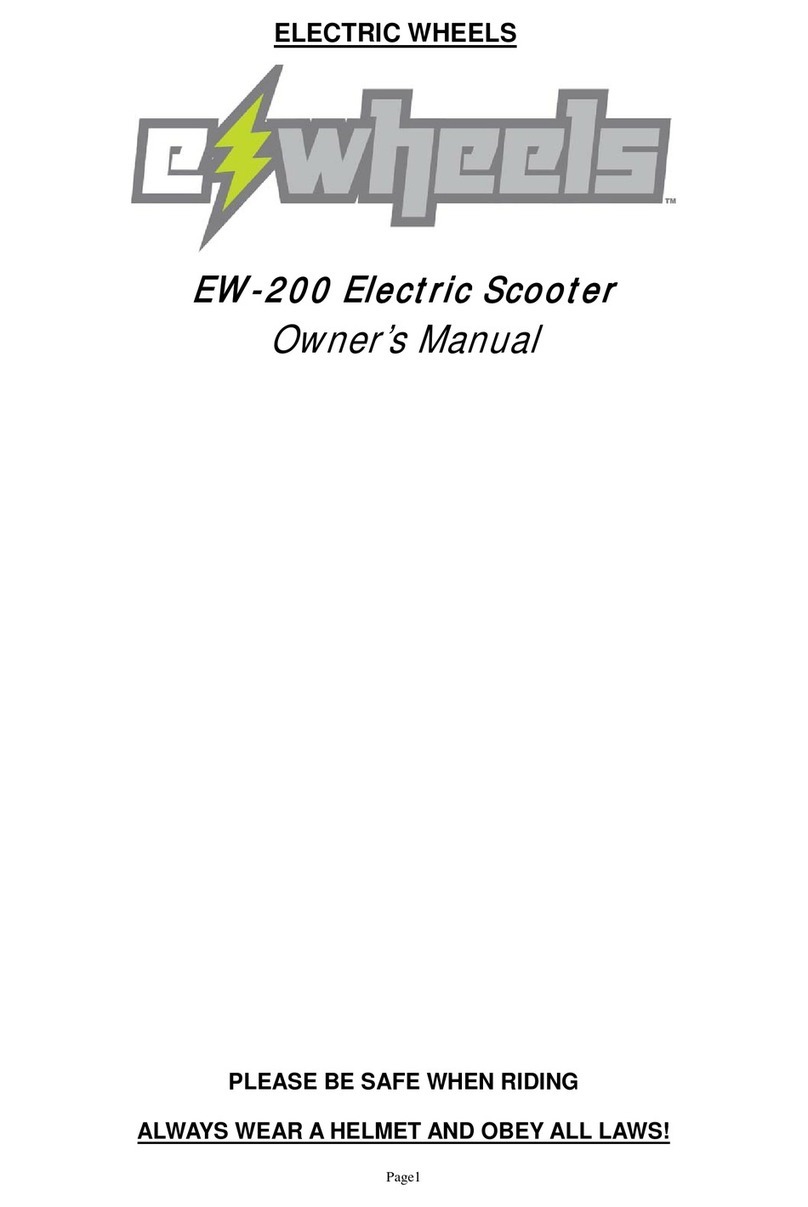
ewheels
ewheels EW-200 User manual
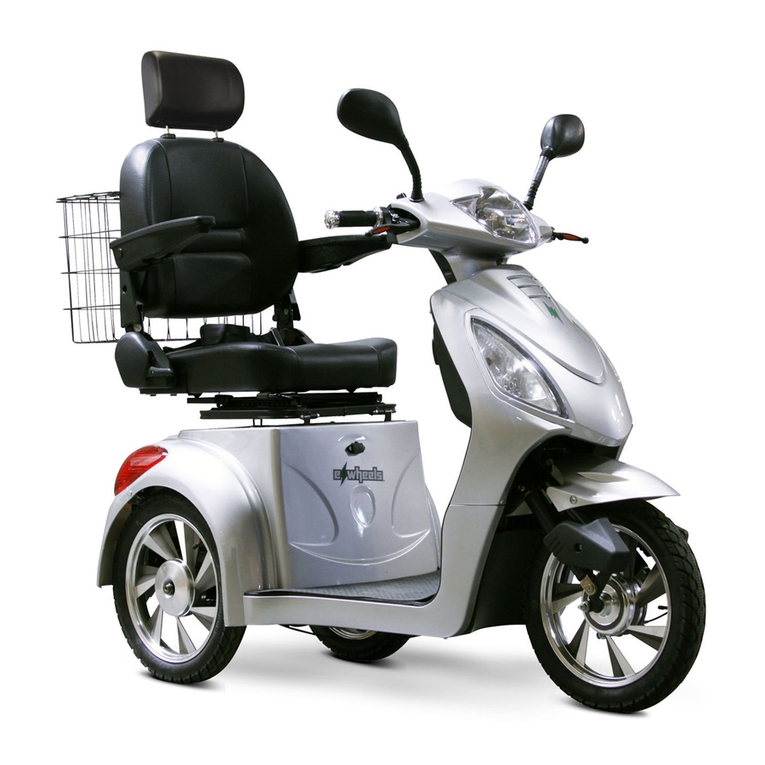
ewheels
ewheels EW-36 User manual

ewheels
ewheels EW-36 User manual
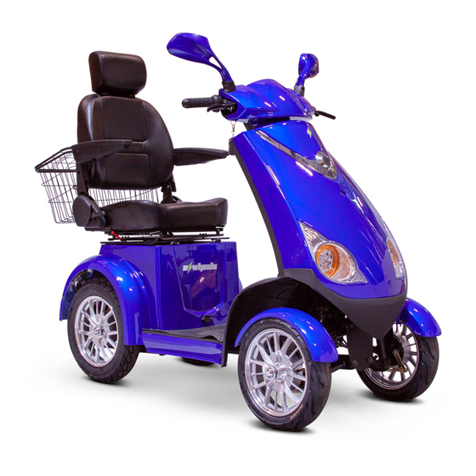
ewheels
ewheels EW-72 Operating instructions
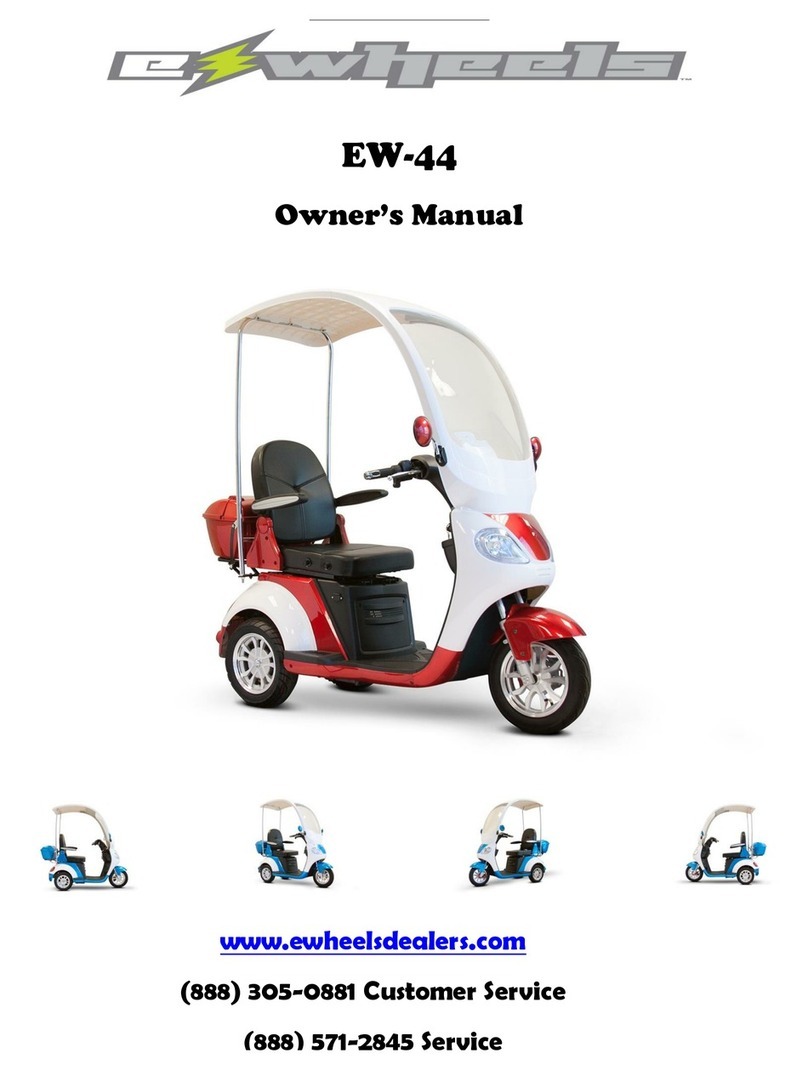
ewheels
ewheels EW-44 User manual
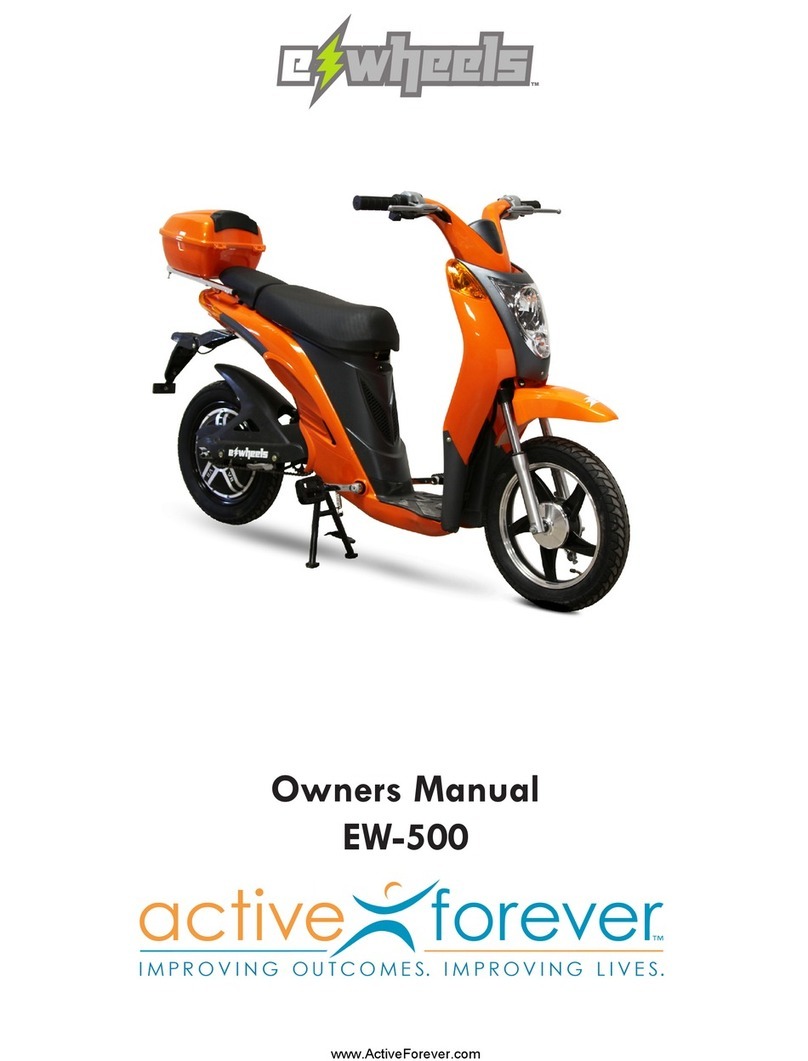
ewheels
ewheels EW-500 User manual
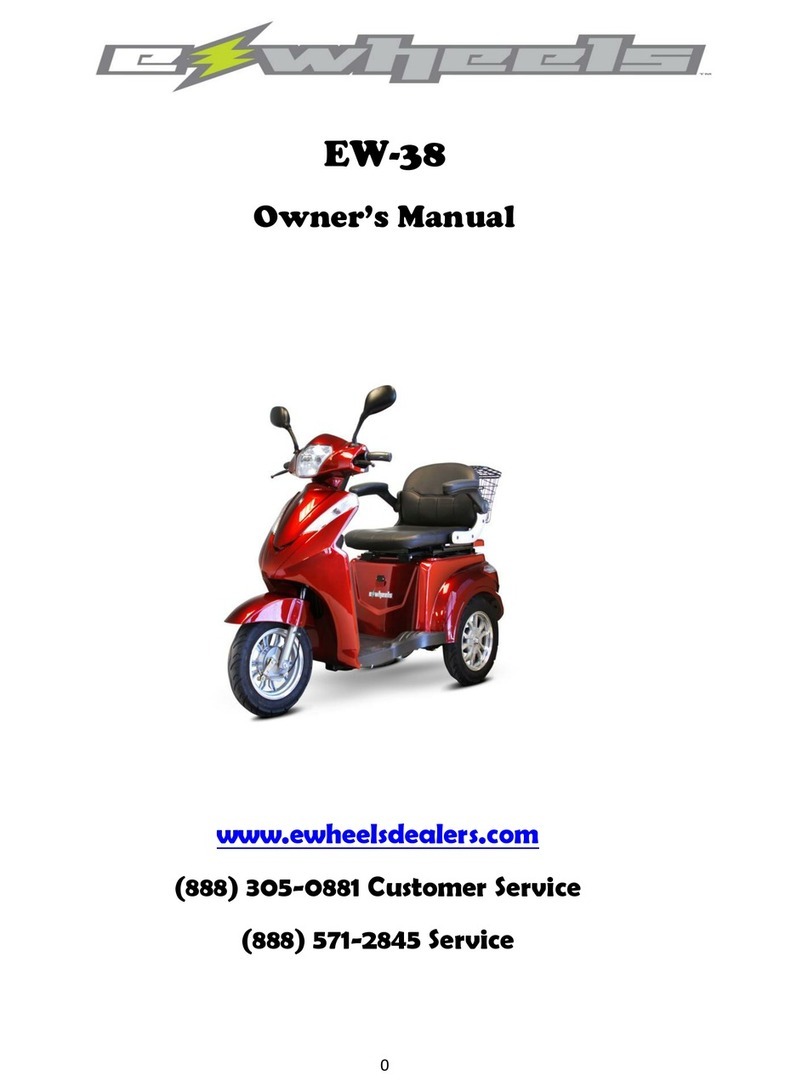
ewheels
ewheels EW-38 User manual
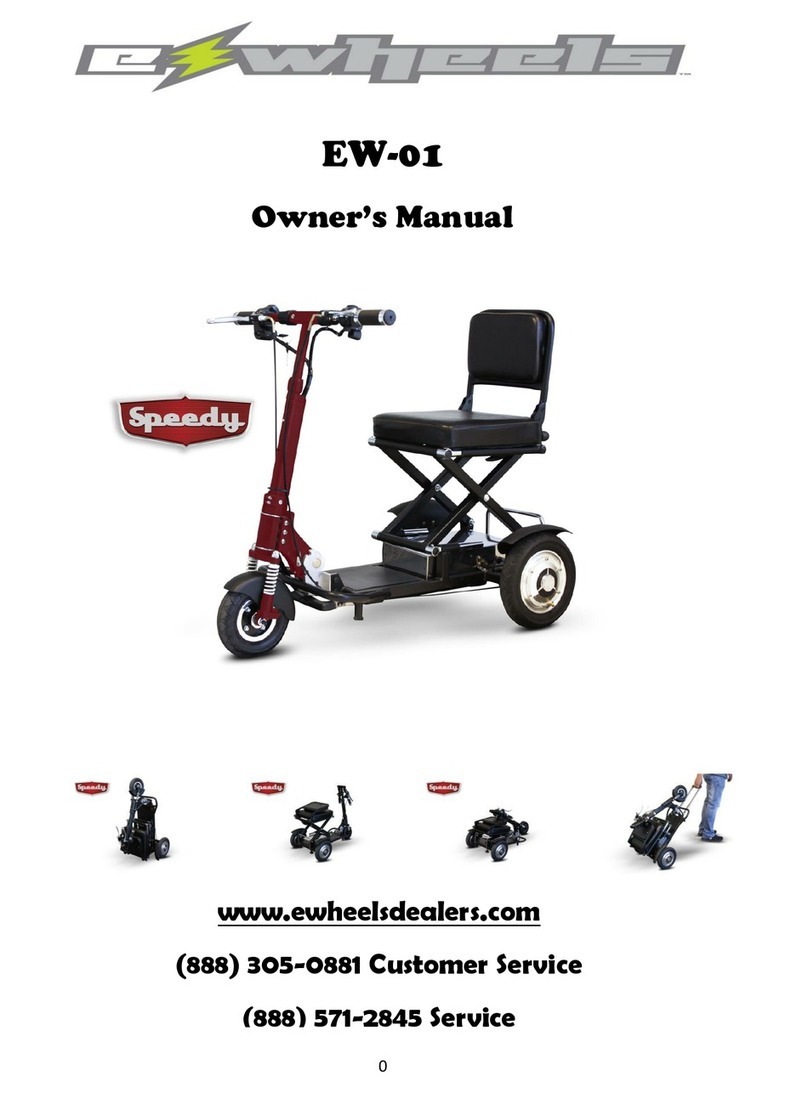
ewheels
ewheels EW-01 User manual
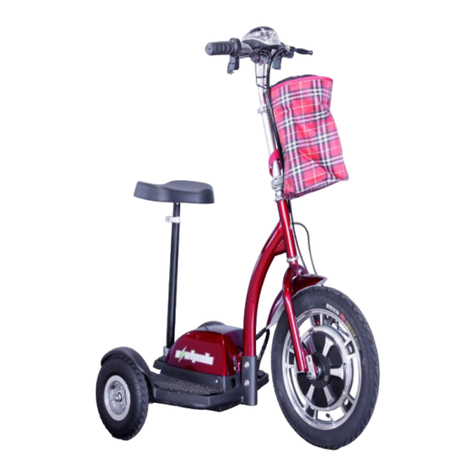
ewheels
ewheels EW-18 User manual
